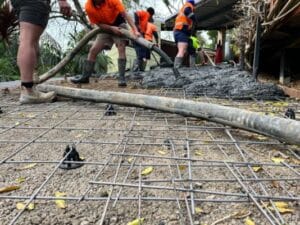The best tips to minimise cracks on concrete driveways are to not add too much water, cure it carefully, use control joints, and prepare its base well. Reliable concreters apply all of these to ensure that the concrete surface will have the best chance of lasting a long time without experiencing cracks.
In this post, we’ll learn more about the tips to prevent cracks on concrete driveways as much as possible.
Don’t Add Too Much Water
Mixing concrete can be difficult, and inexperienced DIY enthusiasts may be tempted to add additional water to simplify the process. However, this should be approached with caution since even a small amount of excess water can undermine the strength of the concrete. When the mixture is laid, any excess water evaporates, resulting in shrinkage and, in due course, cracks.
Choosing the appropriate type of concrete mix for the job is crucial and following the instructions precisely to ensure success. If necessary, add water sparingly to remove any dry spots.
Cure Concrete Carefully
While concrete requires nearly a month to fully cure, the first few days after pouring are critical to curing. The actions taken during this period significantly affect whether shrinkage cracks will form.
Despite being mainly a cosmetic issue, the cracks that emerge, often known as map cracks, can detract from the visual appeal of the surface. Occasionally, these cracks can be severe and compromise the durability and stability of the finish. It’s essential to keep the concrete damp and avoid placing any weight on it after pouring.

Apply Control Joints
Cracking in concrete is unavoidable, but incorporating control joints can prevent them from appearing haphazardly. These joints channel cracks to designated areas that can be readily fixed using a concrete sealant.
Introducing the control joints within a day of pouring the concrete is recommended. Various methods can be employed, including hand-tooling with adaptable concrete, using flexible wood fibre or plastic strips, or waiting until the concrete is firm enough to saw and create the joints.
Prepare the Base Well
A properly prepared base can minimise the likelihood of premature settlement cracks. To achieve this, the subgrade should be level, firmly compacted, and drained well. Failure to create a sturdy and stable foundation can result in increased movement of the concrete slabs, resulting in cracks.
Avoiding loose soil is crucial, so refrain from digging excessively deep while preparing the subgrade. This can necessitate refilling the space with additional soil, exacerbating settlement problems.

Extra Tip: Reinforce the Driveway
Adding rebar to a concrete driveway is a common technique to prevent cracking and increase its structural integrity. The rebar is typically placed in a grid pattern, with bars set approximately two feet apart, running both vertically and horizontally. This reinforcement provides support and reduces the potential for the concrete to shift, resulting in fewer cracks.
By adding rebar during construction, homeowners can ensure that their driveway remains durable and maintains its appearance for years to come.Want to learn how to construct a concrete driveway? Read our blog to find out.
